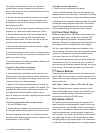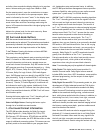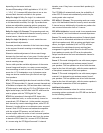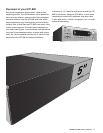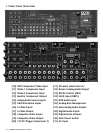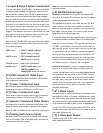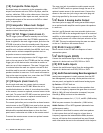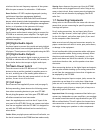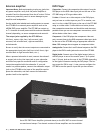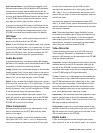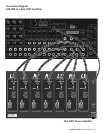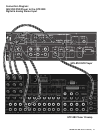
| ADCOM GTP-880 Owner’s Manual14
15ADCOM GTP-880 Owner’s Manual |
[
18
]
Composite Video Inputs
Use these inputs for connection to the composite video
output from sources such as a DVD or LD player, satellite
receiver, cable box, PVR or other video source. Note that
when the component video inputs are used, connect the
analog audio outputs of the source to the DVD or video 1
jacks, as appropriate.
[
19
]
Composite Video main Output
Connect this output to the composite video input of your
monitor or other video display device.
[
20
]
12V DC Trigger (main/room 2)
The DC trigger jacks are used to remotely turn-on other
devices in your system when the GTP-880 is powered on.
Power is applied to the main trigger output jack when the
GTP-880 is turned on from the standby mode. We recom-
mend that this jack be used to turn on a compatible power
amplifier such as those available from ADCOM, but it may
also be used to activate compatible products such as
projection screens or motorized blinds.
Connect a mono mini-plug between the DC trigger main
jack on the rear panel of the GTP-880 and the low voltage
trigger jack of the device to be controlled to enable re-
mote turn-on of that component. The room 2 trigger jack
is activated when the room two system is turned on and
should be used for control of amplifiers used to power the
speakers installed in room two. It will remain activated as
long as the room two system is on, even when the GTP-880
is in the standby mode for the main room.
[
21
]
IR Inputs (main/room 2)
Use the main and room two remote jacks to connect
external IR sensors to the GTP-880. When the unit is
installed behind doors or where it is not otherwise visible
to the remote, connect an optional, external sensor to the
main jack. To control the GTP-880’s room two system from
a remote location, connect an optional remote sensor in
the second room to the room two jack.
The remote jacks allow you to extend the on-board remote
control sensor on the GTP-880’s front panel so that you may
continue to control the GTP-880 even when it is installed
behind solid or smoked cabinet doors or when the front
panel sensor is otherwise not visible to the remote control.
To extend the remote sensor connect an optional remote
sensor to the main jack.
The room two jack is provided to enable remote control
of the GTP-880’s room two system through the use of an
optional remote sensor in the second room. Connect the
sensor to the room two jack using a mono mini-plug and
the wiring specified by the sensor’s manufacturer.
[
22
]
Room 2 Analog Audio Output
Use these jacks to supply the analog stereo audio output
to an optional audio amplifier used to power the speakers
in room two.
Use the L and R channel room two out audio jacks to con-
nect the GTP-880 to the analog audio inputs of an external
amplifier or other audio component in a second room. The
analog signal present will reflect the input selection of the
GTP-880. This may be adjusted using the room two menu
or the rm. 2 button on the remote control.
[
23
]
RS232 Control (DB9)
Allows control of the GTP-880 via computer or home
automation system.
[
24
]
SACD Inputs (DB25)
Connect the multichannel signal from the analog audio
outputs of a device such as a DVD, DVD-A or SACD.
[
25
]
DVD Audio Inputs
Connect the multichannel signal from the analog audio
outputs of a device such as a DVD, DVD-A or SACD.
[
26
]
Multichannel Analog Bass Management
Analog bass management is totally separate from the DSP
bass management, set up using a three position switch on
the rear panel, and applied to multichannel analog inputs.
Up Position: LPF/HPF both on
This position is ideal for owners who have speakers that
only have a frequency response that goes down to around
80Hz (@-3dB). All bass information is summed, low-pass-
filtered (@ 80Hz) and sent to the subwoofer.
80Hz high-pass crossover for L, C, R, LS, and RS: (12dB/octive)
80Hz low-pass crossover for subwoofer: (12dB/octive)
Middle Position: LPF on/HPF bypassed (subwoofer bass
reinforcement mode)
This position is also ideal for owners who have speakers
in their system that are full range (or at least have a
frequency response that extends below 80Hz) however
the user still desires that summed and low-pass-filtered
audio information be sent to the subwoofer which helps to





